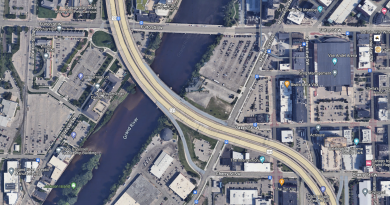Expanded Affordability Ordinance Passes in Detroit
This morning I attended a public hearing for a proposed city ordinance that would require any development project receiving public subsidy to include expanded affordability requirements. The ordinance passed, and the city will also create and fund a housing trust fund to be used for the creation of affordable housing.
Multifamily developers in Detroit currently operate informally under the 80/20 rule in Councilmember Mary Sheffield‘s original incarnation of the ordinance (which provides for 80% area median income “affordability” standards for 20% of the units) and have lobbied against efforts to promote increased affordability in Detroit as values in the urban core have risen to “insane” levels in the past two years, pricing out longtime residents. Alongside the ongoing crisis of expropriation resulting from tax foreclosures, decades of bad tax assessment policy, and water bills, rising real estate prices are bringing the “G” word to the fore.
THE PROBLEM WITH HUD’S AMI STANDARDS
Proponents of expanding the 80/20 standard observe that the AMI requirements are for the entire Detroit metro area, which has a household income about three times that of the city proper– we are, outside of the People’s Republic of Gilbertistan and various and sundry neighborhoods, a poor city. So, realistically, 100% AMI for the city itself would be about 30% AMI for the metro, which sounds to a funder or developer like super low-income housing. Of course, 80% AMI still sounds pretty exorbitant in a city where wages are stagnant and car insurance costs as much as a house— Fortune highlighted Chase Bank’s ongoing investment in the Motor City and toured an “affordable” unit to be rented for $944 per month.
Proponent, community advocate Aaron Handelsman, who pushed for the ordinance with the Detroit People’s Platform, offered a critique that “developers they are speaking as though is a building issue, a profit issue, a market issue, but affordable housing is a people issue.” It is a profit issue to some degree, but it’s definitely erroneously painted as a fundamental limitation on profit. In addition to the plethora of resources out there for developers working with LIHTC or CDFI dollars, the market for affordable units is always strong. As I’m looking for an apartment, I’ve noticed that the units close to $2 per square foot remain open for weeks, while apartments at $1.25 a foot or less are leased out within days– simple supply and demand, and the market is getting saturated at the higher end.
SYNERGIES: DENSITY BONUSES
Affordability requirements may reduce margins by reducing cash flows, but it also should go without saying that this is an excellent opportunity to consider tradeoffs for increased affordability alongside increased density.
Density bonuses are a tried-and-true way to gain developer buy-in. It’s pretty simple math– you balance a less profitable unit with increasing the number of more profitable ones. I realize that I am in the minority of people in Detroit that wants to see neighborhoods that boast 15,000 or 30,000 people per square mile (like, Chicago or New York or Philly densities), but this is a great opportunity to explore that discussion.
Especially in areas where it is easy to satisfy lots and lots of demand at the crazy high price point, like Corktown, it is easy to imagine upzoning or densifying to create affordability. As I observed in my examination of the Tiger Stadium site redevelopment, a full half of the frontage along Michigan Avenue remains pretty much undeveloped– parking lots and set back buildings. I posed the question of what it would look to pack the entire area between Michigan and the freeway with apartments within the B4-zoned area at a floor-area ratio (FAR) of 2.00:
“…this would work out to about 1,607 new units. Fortunately, the byzantine B4 classification, which allows pretty much anything and covers most of the district, permits FAR of up to 2.00 (even if it has preposterous setback requirements)– so let’s go up to 2.00, which brings us to 2,570 apartments… At the conservative FAR = 1.25 and no variances required under the B4 classification […] we would increase Corktown’s population by 135%. Is Detroit ready for the resulting 20,000 people per square mile who would at that point occupy the 0.08 sq. mi. space between I-75 and Michigan Avenue?”
If the city offered a 15% density bonus to include affordable housing, that wouldn’t even require rocket science (or LIHTC, really) to squeeze some bucks out of any dense project. I’m optimistic about what has been accomplished today.


